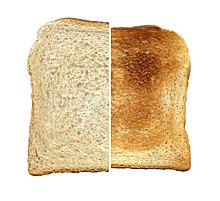Portal:Cooking
Introduction

Cooking, also known as cookery or professionally as the culinary arts, is the art, science and craft of using heat to make food more palatable, digestible, nutritious, or safe. Cooking techniques and ingredients vary widely, from grilling food over an open fire, to using electric stoves, to baking in various types of ovens, reflecting local conditions. Cooking is an aspect of all human societies and a cultural universal.
Types of cooking also depend on the skill levels and training of the cooks. Cooking is done both by people in their own dwellings and by professional cooks and chefs in restaurants and other food establishments. (Full article...)
Selected general articles
-
Braising (from the French word braiser) is a combination-cooking method that uses both wet and dry heats: typically, the food is first browned at a high temperature, then simmered in a covered pot in cooking liquid (such as wine, broth, coconut milk or beer). It is similar to stewing, but braising is done with less liquid and usually used for larger cuts of meat. Braising of meat is often referred to as pot roasting, though some authors make a distinction between the two methods, based on whether additional liquid is added. Osso buco and coq au vin are well known braised meat dishes, and the technique can also be used to prepare fish, tempeh, tofu, or fruits and vegetables. (Full article...)
-
A purée (or mash) is cooked food, usually vegetables, fruits or legumes, that has been ground, pressed, blended or sieved to the consistency of a creamy paste or liquid. Purées of specific foods are often known by specific names, e.g., apple sauce or hummus. The term is of French origin, where it meant in Old French (13th century) purified or refined.
Purées overlap with other dishes with similar consistency, such as thick soups, creams (crèmes) and gravies—although these terms often imply more complex recipes and cooking processes. Coulis (French for "strained") is a similar but broader term, more commonly used for fruit purées. The term is not commonly used for paste-like foods prepared from cereal flours, such as gruel or muesli; nor with oily nut pastes, such as peanut butter. The term "paste" is often used for purées intended to be used as an ingredient, rather than eaten. (Full article...) -
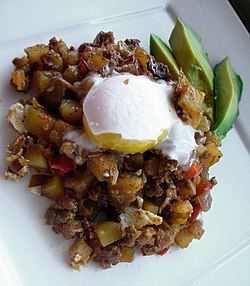
Coddled egg
In cooking, to coddle food is to heat it in water kept just below the boiling point. In the past, recipes called for coddling fruit, but in recent times the term is usually only applied to coddled eggs. Coddling differs from poaching in that the coddled ingredient is not placed directly in hot water, but instead in a small dish placed in a hot water bath. The process is either done in a regular pan or pot filled with water, either on the stovetop or placed in the oven, or through the use of a special device such as an "egg coddler" (originally known as a pipkin). The oven technique is similar to the preparation of baked eggs, the difference being that the preparation of baked eggs does not have to employ a water bath.
The word coddle evolved from the name of a warm drink, "caudle", and ultimately deriving from the Latin word for warm drink, calidium. (Full article...) -

Salmon being poached with onion and bay leaves
Poaching is a cooking technique that involves heating food submerged in a liquid, such as water, milk, stock or wine. Poaching is differentiated from the other "moist heat" cooking methods, such as simmering and boiling, in that it uses a relatively lower temperature (about 70–80 °C (158–176 °F)). This temperature range makes it particularly suitable for delicate food, such as eggs, poultry, fish and fruit, which might easily fall apart or dry out using other cooking methods. Poaching is often considered a healthy cooking method because it does not use fat for cooking or flavoring the food. (Full article...) -
Eggs being gently fried
Gentle frying or low-temperature frying is an oil- or fat-based cooking method used for relatively fragile or starchy foods. While gentle frying is most notably used to cook fried eggs, it is also used for delicate fish, tender cuts of meat, sausages, and as a first step in fried potatoes. (Full article...) -

Vegetables being sweated, showing a lack of browning
Sweating in cooking is the gentle heating of vegetables in a little oil or butter, with frequent stirring and turning to ensure that any emitted liquid will evaporate. Sweating usually results in tender, sometimes translucent, pieces. Sweating is often a preliminary step to further cooking in liquid; onions, in particular, are often sweated before including in a stew. This differs from sautéing in that sweating is done over a much lower heat, sometimes with salt added to help draw moisture away, and making sure that little or no browning takes place.
The sweating of vegetables has been used as a technique in the preparation of coulis. (Full article...) -

Seared tuna
Searing or pan searing is a technique used in grilling, baking, braising, roasting, sautéing, and the like, in which the surface of the food (usually meat such as beef, poultry, pork, or seafood) is cooked at high temperature until a browned crust forms. Similar techniques, such as browning and blackening, are typically used to sear all sides of a particular piece of meat, fish, poultry, etc. before finishing it in the oven. To obtain the desired brown or black crust, the meat surface must exceed 150 °C (300 °F), so searing requires the meat surface be free of water, which boils at around 100 °C (212 °F).
Although often said to "lock in the moisture" or "seal in the juices", in fact, searing results in a greater loss of moisture than cooking to the same internal temperature without searing. Nonetheless, it remains an essential technique in cooking meat for several reasons: (Full article...) -
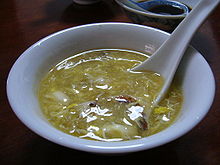
Shark fin soup
Double steaming, sometimes called double boiling, is a Chinese cooking technique to prepare delicate food such as bird's nest soup and shark fin soup. The food is covered with water and put in a covered ceramic jar and the jar is then steamed for several hours. This technique ensures there is no loss of liquid or moisture (its essences) from the food being cooked, hence it is often used with expensive ingredients like Chinese herbal medicines.
In Cantonese, double steaming is called dun (simplified Chinese: 炖; traditional Chinese: 燉; pinyin: dùn). The meaning of the Chinese character for dun in Cantonese is different from that in Mandarin, because dun means to simmer or stew in Mandarin. This technique is also common in Fujian, a neighbouring province of Guangdong (Canton). (Full article...) -

Infusion is the process of extracting chemical compounds or flavors from plant material in a solvent such as water, oil or alcohol, by allowing the material to remain suspended in the solvent over time (a process often called steeping). An infusion is also the name for the resultant liquid. The process of infusion is distinct from both decoction—a method of extraction involving boiling the plant material—and percolation, in which water is passed through the material (as in a coffeemaker). (Full article...) -
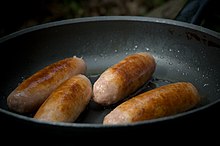
Pan frying sausages can make use of the inherent fat of the meat.
Pan frying or pan-frying is a form of frying food characterized by the use of minimal cooking oil or fat (compared to shallow frying or deep frying), typically using just enough to lubricate the pan. In the case of a greasy food such as bacon, no oil or fats may need to be added. As a form of frying, the technique relies on oil or fat as the heat transfer medium, and on correct temperature and time to not overcook or burn the food. Pan frying can serve to retain the moisture in foods such as meat and seafood. The food is typically flipped at least once to ensure that both sides are cooked properly. (Full article...) -

Steaks and chicken breasts being grilled over charcoal
Grilling is a form of cooking that involves heat applied to the surface of food, commonly from above, below or from the side. Grilling usually involves a significant amount of direct, radiant heat, and tends to be used for cooking meat and vegetables quickly. Food to be grilled is cooked on a grill (an open wire grid such as a gridiron with a heat source above or below), using a cast iron/frying pan, or a grill pan (similar to a frying pan, but with raised ridges to mimic the wires of an open grill).
Heat transfer to the food when using a grill is primarily through thermal radiation. Heat transfer when using a grill pan or griddle is by direct conduction. In the United States, when the heat source for grilling comes from above, grilling is called broiling. In this case, the pan that holds the food is called a broiler pan, and heat transfer is through thermal radiation. (Full article...) -
Creaming is used to refer to several different culinary processes. In baking, it is the blending of ingredients with a softened form of a solid fat. When a dish is described as being "creamed", it may mean that it has been poached in milk, cream or a similar liquid. "Creaming" can also refer to the separation of cream from milk. (Full article...)
-

Shocking broccoli in cold water
Shocking is a cooking process wherein the food substance, usually a vegetable or fruit, is plunged into iced water or placed under cold running water to halt the cooking process. This process usually keeps the colour, taste and texture of a fruit or vegetable. (Full article...) -
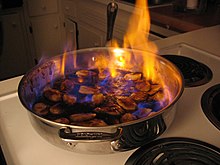
Bananas Foster includes a flambé.
Flambéing is often associated with the tableside presentation of certain liqueur-drenched dishes set aflame, such as Bananas Foster or Cherries Jubilee when the alcohol is ignited and results in a flare of blue-tinged flame. However, flambéing is also a step in making coq au vin and other dishes and sauces, using spirits before they are brought to the table. By partially burning off the volatile alcohol, flambéing reduces the alcoholic content of the dish while keeping the flavors of the liquor. (Full article...) -
Slow-roasting pig on a rotisserie
Roasting is a cooking method that uses dry heat where hot air covers the food, cooking it evenly on all sides with temperatures of at least 150 °C (300 °F) from an open flame, oven, or other heat source. Roasting can enhance the flavor through caramelization and Maillard browning on the surface of the food. Roasting uses indirect, diffused heat (as in an oven), and is suitable for slower cooking of meat in a larger, whole piece. Meats and most root and bulb vegetables can be roasted. Any piece of meat, especially red meat, that has been cooked in this fashion is called a roast. Meats and vegetables prepared in this way are described as "roasted", e.g., roasted chicken or roasted squash. (Full article...) -

Flattened fish drying in the sun in Madagascar. Fish are preserved through such traditional methods as drying, smoking and salting.
Food drying is a method of food preservation in which food is dried (dehydrated or desiccated). Drying inhibits the growth of bacteria, yeasts, and mold through the removal of water. Dehydration has been used widely for this purpose since ancient times; the earliest known practice is 12,000 B.C. by inhabitants of the modern Middle East and Asia regions. Water is traditionally removed through evaporation by using methods such as air drying, sun drying, smoking or wind drying, although today electric food dehydrators or freeze-drying can be used to speed the drying process and ensure more consistent results. (Full article...) -
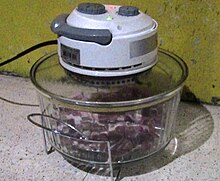
A tabletop convection oven cooking pork. For slower cooking, the gridiron here has been reversed to place the meat low and far from the main heat source (at the top of the pot), although near the heat of the glass pot's bottom. Flipping the gridiron would raise the meat closer to the main heat source.
A convection oven (also known as a fan-assisted oven, turbo broiler or simply a fan oven or turbo) is an oven that has fans to circulate air around food to create an evenly heated environment. The increased air circulation causes a fan-assisted oven to cook food faster than a conventional non-fan oven, which relies only on natural convection to circulate the hot air. Fan-assisted convection ovens are commonly used for baking as well as non-food, industrial applications. Small countertop convection ovens for household use are often marketed as air fryers.
When cooking using a fan-assisted oven, the temperature is usually lower compared to that of a non-fan oven, often by 20 °C (40 °F), to avoid overcooking the outside of the food. (Full article...) -

Fried plantain
Frying is the cooking of food in oil or another fat. Similar to sautéing, pan-fried foods are generally turned over once or twice during cooking to make sure that the food is well-made, using tongs or a spatula, while sautéed foods are cooked by "tossing in the pan". A large variety of foods may be fried. (Full article...) -

Browning is the process of partially cooking the surface of meat to develop its flavor through various browning reactions and give it a more attractive color.
It is a common first step in cooking braised meats and stews. (Full article...) -
A microwave oven or simply microwave is an electric oven that heats and cooks food by exposing it to electromagnetic radiation in the microwave frequency range. This induces polar molecules in the food to rotate and produce thermal energy in a process known as dielectric heating. Microwave ovens heat foods quickly and efficiently because excitation is fairly uniform in the outer 25–38 mm (1–1.5 inches) of a homogeneous, high-water-content food item.
The development of the cavity magnetron in the United Kingdom made possible the production of electromagnetic waves of a small enough wavelength (microwaves) to efficiently heat up water molecules. American electrical engineer Percy Spencer is generally credited with inventing the modern microwave oven after World War II from radar technology developed during the war. Named the "RadaRange", it was first sold in 1947. (Full article...) -
Toast is sliced bread that has been browned by radiant heat. The browning is the result of a Maillard reaction altering the flavor of the bread and making it firmer. The firm surface is easier to spread toppings on and the warmth can help butter reach its melting point. Toasting is a common method of making stale bread more palatable. Bread is commonly toasted using a toaster or a toaster oven. Toast may contain acrylamide caused by the browning process, which is suspected to be a carcinogen. However, claims that acrylamide in burnt toast causes cancer have not been proven.
Butter or margarine, and sweet toppings, such as jam or jelly, are commonly spread on toast. Regionally, savory spreads, such as peanut butter or yeast extract, may also be popular. Toast may accompany savory dishes such as soups or stews, or it can be topped with ingredients like eggs or baked beans to make a light meal. Toast is a common breakfast food. A sandwich may also use toasted bread. (Full article...) -

The first step in blanching green beans
Blanching is a cooking process in which a food, usually a vegetable or fruit, is scalded in boiling water, removed after a brief timed interval, and finally plunged into iced water or placed under cold running water (known as shocking or refreshing) to halt the cooking process. Blanching foods helps reduce quality loss over time. Blanching is often used as a treatment prior to freezing, dehydrating, or canning vegetables or fruits to deactivate enzymes, modify texture, remove the peel and wilt tissue. The inactivation of enzymes preserves colour, flavour, and nutritional value. The process has three stages: preheating, blanching, and cooling. The most common blanching methods for vegetables/fruits are hot water and steam, while cooling is either done using cold water or cool air. Other benefits of blanching include removing pesticide residues and decreasing microbial load. Drawbacks to the blanching process can include leaching of water-soluble and heat-sensitive nutrients and the production of effluent. (Full article...) -
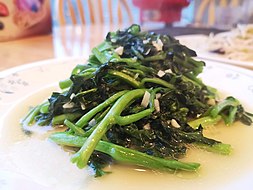
Stir-fried watercress
Stir frying (Chinese: 炒; pinyin: chǎo; Wade–Giles: ch'ao3; Cantonese Yale: cháau) is a cooking technique in which ingredients are fried in a small amount of very hot oil while being stirred or tossed in a wok. The technique originated in China and in recent centuries has spread into other parts of Asia and the West. It is similar to sautéing in Western cooking technique.
Wok frying may have been used as early as the Han dynasty (206 BC – 220 AD) for drying grain, not for cooking. It was not until the Ming dynasty (1368–1644) that the wok reached its modern shape and allowed quick cooking in hot oil. However, there is research indicating that metal woks and stir-frying of dishes were already popular in the Song dynasty (960–1279), and stir-frying as a cooking technique is mentioned in the 6th-century AD Qimin Yaoshu. Stir frying has been recommended as a healthy and appealing method of preparing vegetables, meats, and fish, provided calories are kept at a reasonable level. (Full article...) -
Juice extracted using an electric centrifugal juicer
Juicing is the process of extracting juice from plant tissues such as fruit or vegetables. (Full article...) -

Meat being barbecued at The Salt Lick restaurant
Barbecue or barbeque (often shortened to BBQ in the UK, US, and Canada; barbie or barby in Australia and New Zealand; and braai in South Africa) is a term used with significant regional and national variations to describe various cooking methods that employ live fire and smoke to cook the food. The term is also generally applied to the devices associated with those methods, the broader cuisines that these methods produce, and the meals or gatherings at which this style of food is cooked and served. The cooking methods associated with barbecuing vary significantly but most involve outdoor cooking.
The various regional variations of barbecue can be broadly categorized into those methods which use direct and those which use indirect heating. Indirect barbecues are associated with North American cuisine, in which meat is heated by roasting or smoking over wood or charcoal. These methods of barbecue involve cooking using smoke at low temperatures and long cooking times, for several hours. Elsewhere, barbecuing more commonly refers to the more direct application of heat, grilling of food over hot coals or a gas fire. This technique is usually done over direct, dry heat or a hot fire for a few minutes. Within these broader categorizations are further national and regional differences. (Full article...)
Did you know...
- ... that The Art of Cooking with Cannabis by Tracey Medeiros was praised by the Los Angeles Times for showcasing a wide range of recipes outside of the "tired pot-brownie cliché"?
Get involved
For editor resources and to collaborate with other editors on improving Wikipedia's Cooking-related articles, see WikiProject Food and drink.
Need help?
Do you have a question about Cooking that you can't find the answer to?
Consider asking it at the Wikipedia reference desk.
Selected images
-
Vegetables contain important vitamins and minerals (from Cooking)
Subcategories
Subtopics
Related portals
Associated Wikimedia
The following Wikimedia Foundation sister projects provide more on this subject:
-
Commons
Free media repository -
Wikibooks
Free textbooks and manuals -
Wikidata
Free knowledge base -
Wikinews
Free-content news -
Wikiquote
Collection of quotations -
Wikisource
Free-content library -
Wikiversity
Free learning tools -
Wiktionary
Dictionary and thesaurus




















